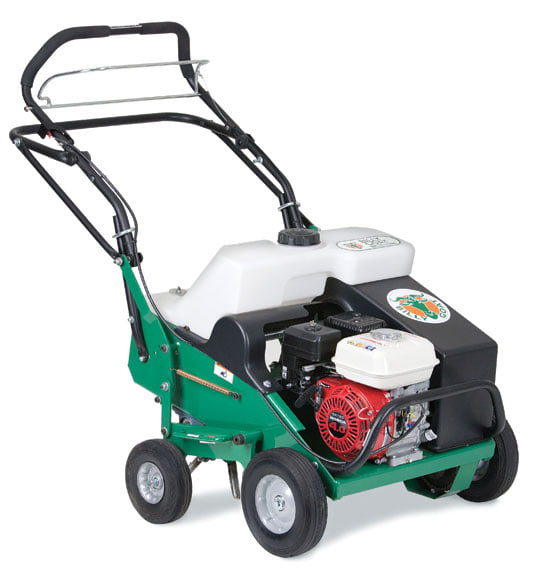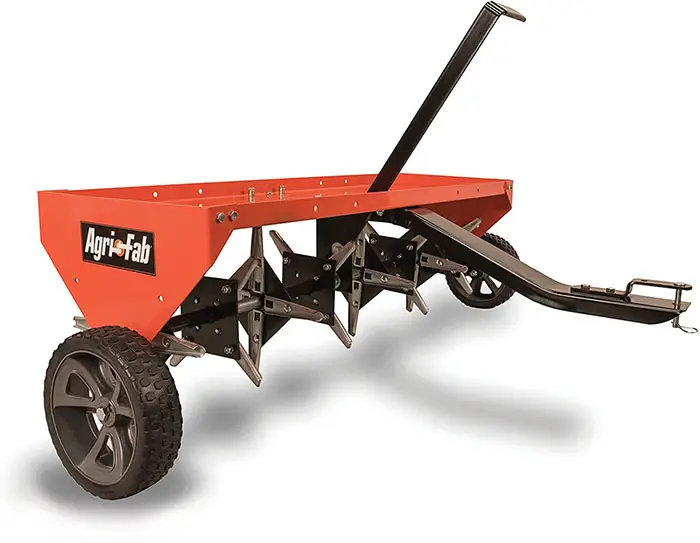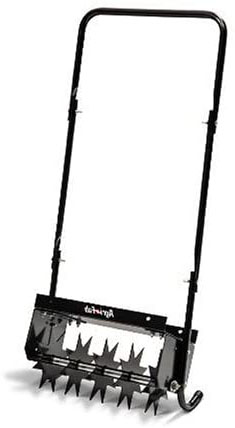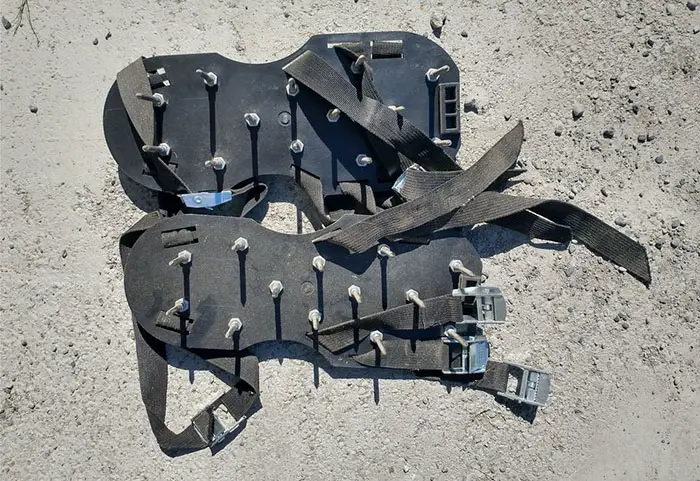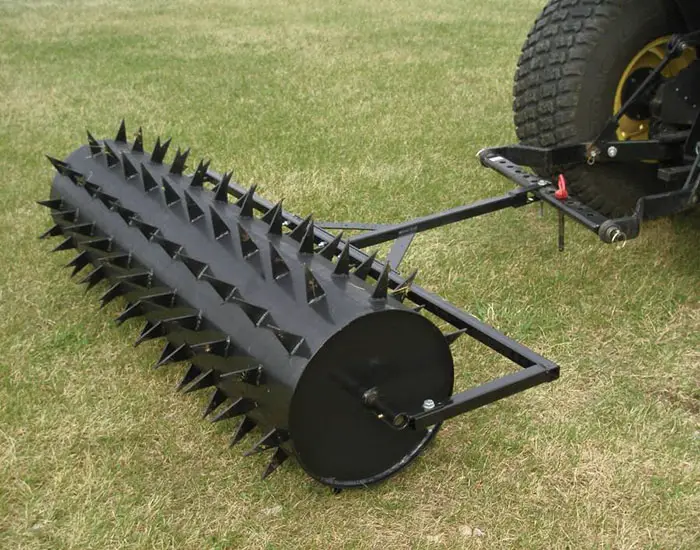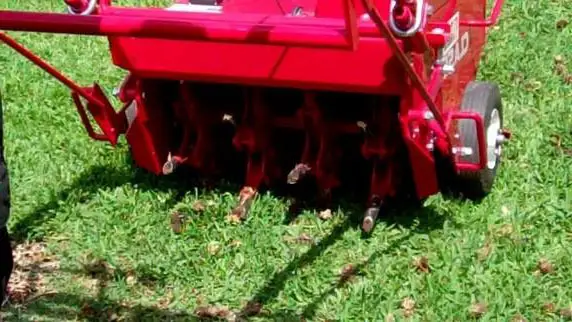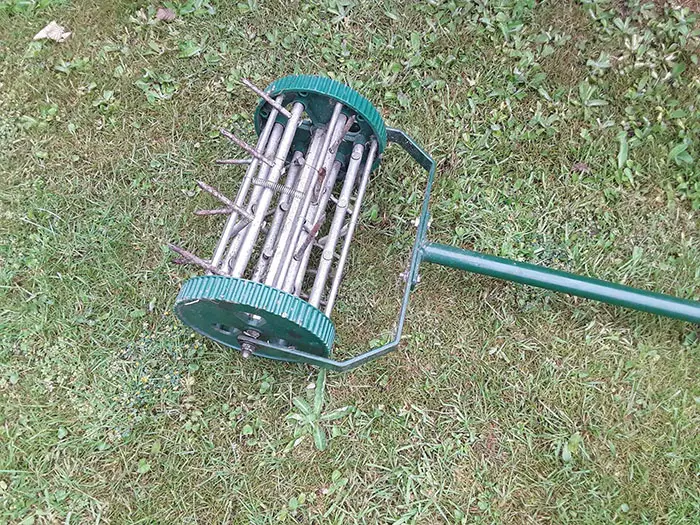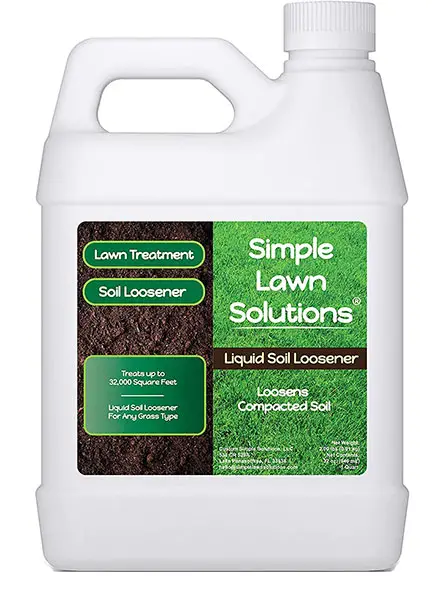There are many different types of lawn aerators that you can use to aerate a lawn. Among them are include core, spike, plug, rolling, and liquid aerator.
In my opinion, the best type of lawn aerator you can use is a core aerator. You can either buy a hand lawn aerator, or you can rent one. The advantage of buying a hand aerator is that it will be cheaper, and you can do it several times. It will be easier to rent a lawn aerator, but you will have to rent one every year.
Core Aerators
1. Manual Coring Aerators
These are great hand aerators to use for aerating your lawn. The best ones you can use have prongs and are foot push. You can buy some of these that are really nice at your local store for around $25. if you have a small lawn or only aerate your lawn once a year, these are the ideal aerators for you.
Before using them, please water your soil really well the day before so that you can get the most penetration, and it will be easier for you to aerate your lawn with the core aerators.
2. Gas Powered Coring Lawn Aerators
In my opinion, a gas-powered coring aerator is probably the easiest way that you can aerate your lawn. I prefer core aerators to spike aerators because they have longer-lasting plugs, and because they actually removed course from your lawn, they will give the top of the soil room to expand as the clay in the soil heats up.
Another advantage of using a machine is that it will only take one-half hour to aerate the average size lawn, and if you want to go over the lawn two times, it will only take you an extra 20 min.
Main Benefits of Core Aerators
Below are some reasons why these types of aerators are better than any other type of aerator on the market:
A core lawn aerator has hollow tines. As it removes cores out of the lawn, giving the soil more room for expansion. This is essential to building healthy turf. Compacted soils have compacted root systems. The minute it stops raining, these grasses can turn yellow and go dormant. In the summer, clay soil can expand without drastically hardening the surface of the soil.
Core aerators go deep. The most effective lawn aerators go 2 to 3 inches deep. This allows air, water, and nutrient access to the root system directly.
Holes hold water. When you water your lawn after aerating, you will notice water soaking in rather than running off. The holes hold the water. They also allow it to soak in 1 to 2 inches below the surface of the soil. This makes your watering more effective, but it allows promotes deeper root growth.
Core aerators work faster the chemical aerators and are longer lasting than spike aerators. More most lawns, I think spike aerators are a waste of money. The effectiveness of a liquid aerator increases when coupled with mechanical core aeration.
Core aerators are sturdy and will typically last a long time.
The hand aerators are used with smaller jobs (under 500 sq ft). Aeration machines are used with the bigger lawns. You can typically rent one for around $50 or higher someone to do it for you for around that price.
Plug Aerators
Aerating your lawn with a plug aerator keeps it in good condition and helps support a healthy root system that decreases the need for water and fertilizer.
The top two to three inches of soil get compacted over time. Compaction is caused by traffic, temperature, sunlight, and root stress. These factors affect the roots and make it harder for them to get what they need to give you healthy grass.
Plug aerators use hollow tines to plunge into the ground and pull out a dirt plug. This leaves holes that allow improved nutrient, air, sunlight, and water movement to the roots. These holes also keep water, allowing less frequent watering while still keeping the lawn green and healthy.
Plug aeration also break-ups dense clay and heavily compacted soils, leaving more room for roots to grow. Healthier roots and less compacted dirt equals a lawn that can withstand heat, disease, drought, and traffic.
You can hire a professional to aerate your lawn annually or as needed. Ask friends or neighbors for referrals or call lawn care companies. Many professionals will ask you to point out sprinkler heads or other obstructions in your lawn and may want you to water your lawn beforehand. Then they do all the work.
If you want to do the job yourself, you can buy or rent a lawn aerator. The aerator should be heavy enough to get good penetration into the ground yet comfortable for you to use.
Spike Lawn Aerators
Spike aerators work by punching holes or spikes into the lawn. This allows air and water to have direct access to the root system. Over time, this kind of lawn aeration can help a great deal.
Advantages of spike aerators vs. other types of aerators are that they are affordable, convenient to store, and simple to use. Because spike holes are smaller than coring holes, it may be necessary to aerate the lawn more often when using a spike aerator.
1. Push Spike Aerators
A push by an aerator is like a hand coring aerator. Only instead of metal course, it has metal spikes. You use your hands and one foot to push these into the ground. These aerators have rotating star-shaped tines that run along the surface of the ground.
The benefit of using it is that it does not ever get clogged up. Besides, these units are inexpensive and quick to use. The disadvantage is that it is not as long-lasting as using a core lawn aerator. Also, if the soil is compacted, they really don’t sink in well.
2. Spike Aerator Shoes
I have a mixed opinion of these. Half of the reviews I have read on them are positive. They say that they are convenient and easy to use and that you can slide them on when you are going to move your lawn, and you can have it aerated simultaneously.
However, I am not so sure that little spikes are going to do much for your lawn. I don’t think that the holes will last more than a week, but I guess many people will molder the lawn every week anyway, and I really don’t think that they will do any harm to your lawn. So if you think they will work well for you, go ahead and try it out, they are relatively inexpensive, and that is another plus
3. Drum Rolling Spike Aerators
In theory, rolling spike aerators are a good idea, but I’m not sure how effective they are. For an aerator to be effective, it needs to penetrate a minimum depth of 1 inch. 2 to 2 1/2 inches is even better. Also, I want it to allow the water to get down to the root system.
I am not sure that spike aerators will do this very well unless they have thick spikes. So unless you have long, thick spikes, I would not recommend using a rolling spike aerator for your lawn.
You need to make sure it is heavy enough to get the job done. We suggest you use one with a solid metal drum or a drum filled with water or sand.
4. Spike Mowing Aerators
I think that spike mowing wheels are an interesting idea. If you have a lawn that gets slippery when it is wet or on a steep hill, these mowing spikes will help to keep your mower from slipping.
It is like your lawnmower is wearing cleats. However, the spikes on these mowers are so small. I doubt they are of much use. My biggest problem with these is the limited area they cover while mowing and the tiny spikes on the tires. For the cost, these don’t deliver!
5. Spike Hand Aerators
These units have long spikes on end, and you push them into the ground using your hand and your foot. The best advantage to these aerators is that they have deep penetration. The disadvantage is it may take a while to aerate a large lawn.
6. Spiked Towing Aerator
These range in price between $120 and $500. They can cover large areas, and when pulled behind a tractor or riding lawn mower, they are one of the fastest ways to aerate your lawn. If you want an upper-end unit, I will urge you to use a tow-behind aerator and not a spiked one. These tow behinds are a great investment and dramatically cut your water bill.
Rolling Aerators
Rolling aerators give you the easiest way to aerate your lawn, and new features make them easier to use. These promote root growth by breaking up the soil and roots better than other aerators, leading to more new root growth and more readily available water, oxygen, and nutrients for those new roots.
Recent improvements not only do a better job aerating but also make it simpler, so it’s easier for anyone to aerate their own lawn. In general, look for aerators that are easy to use, require minimal maintenance, and withstand the wear and tear of continued use.
Six kinds of Rolling Aerators
Manual aerators allow you to aerate your lawn yourself. They are lightweight and easier to maneuver in small areas such as corners. Still, it takes a lot of time and works to aerate a large lawn this way. Rolling walk-behind and towing aerators are some of the fastest rolling lawn aerators.
Walk-behind aerators go over the lawn like a lawnmower. Since the machine does the work of pushing tines into the ground, they are much easier and faster to use than manual ones. Self-propelled models need even less effort and do a more effective job than lighter-weight machines. The easiest ones to use are lawnmowers.
Many of these maneuvers easily around corners or obstacles, so they are easier to use. Some even have the power life feature that eliminates manually lifting the machine out of the ground. Stand-on aerators offer the added benefit of standing on them as they work and not walk behind them the entire time.
New tine designs make some aerators very easy to use. Aerators with free-wheeling outside tines and fixed center tines make turning easier and reduce lawn damage. Split-tines, where half the tines are controlled by one hand controller and the other half by the other hand, allow the machine to turn with the tines still in the ground.
A tow-behind aerator attaches to a tractor or riding lawnmower, requiring no frequent lifting or pushing and pulling manually. They are tricky to maneuver, but they get a larger job done faster because they are wider.
It is easy to add weight to these types of aerators, increasing their ability to get deep into the dirt of heavily compacted or problem areas. They are great for a large lawn, especially if you already own a tractor or lawnmower to tow them with.
Since aerators can vary in price from a hundred dollars to several thousand, it’s a good idea to shop around for the best prices on the type of aerator you want, considering quality and durability. You may want to rent kinds before you buy one to make sure you find a good one.
Liquid Aerators, Soil Amendments
After a long hard winter, your lawn’s root system is under a lot of stress. Liquid aeration helps your lawn to look its best in the Spring and Summer. Aerating loosens up and conditions the soil. Soil softeners used to aerate the soil actively work for a 2 to 3 month period.
During this period, they promote permanent root development and naturally support organic activity. Loosening the soil allows air, water, and nutrients direct access to the roots system.
These liquid aerators aerate the soil, breaking up clays and hard soils, and conditioning the soil with humic acid. Humic acid help to break down harmful pesticides and herbicides in the soil. Loosening up the soil with a liquid aerator also makes the soil conditions more hospitable to the earth’s natural aerators, the earthworm.
What you should know
Lawn aeration is a long-term process that helps to build the turf. It may take 3-4 yearly of bi-yearly applications to make sure the best results. Eventually, creating a healthy turf requires aeration less often. For very hard or clay soils, it works best to combine liquid aeration with mechanical aeration.
There are three or four different types of liquid aerators on the market. I never use liquid aerators yet. But I know how they work. They use soil softeners and hard clay soils to make your route system grows better.
The best way to use a liquid aerator is to apply it after aerated your lawn with a core aerator. Rather than replacing the need for core aeration, you only enhance the effects of aerating when you use a liquid soil aerator. With a liquid soil aerator for a core aerator, your end goal is the same. You want to have a thick healthy church that can be self-sustaining after a few years.
2. Soil Conditioners or softeners
This is a liquid aerator that contains soil softeners. Another way to soften your lawn followed is to add gypsum to it after going over it twice within the aerator. This helps to break up hard clay and soften the soil. It is also fairly cheap. You want to use about 30 to 40 pounds of soil softener per thousand square feet of lawn you have.
One proven liquid aerator brand is ‘Lazyman liquid soil aerator.’ This liquid aeration compound loosens clays and hard soils naturally and effectively. It is made with a grade A soil penetrate, which penetrates even the toughest soils. It is safe for home use and environmentally friendly.

